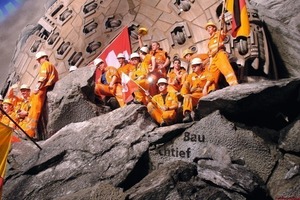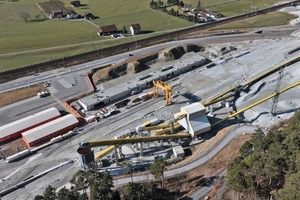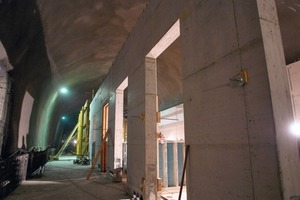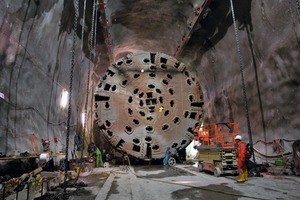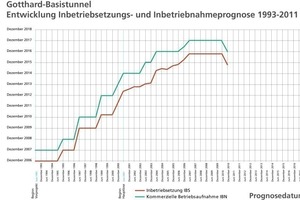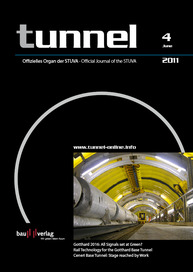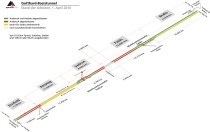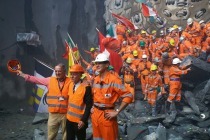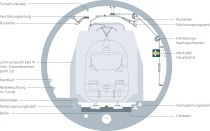Gotthard 2016:
All Signals set at Green?
The construction work for the NEAT Gotthard Axis is on schedule. On March 23, 2011 the second main breakthrough for the Gotthard Base Tunnel was achieved – thus marking the end of driving operations. The installation of the rail technology has started in the Bodio-West section. The aim now is to commission the Gotthard Base Tunnel by the end of 2016.
1 Introduction
2010 represented an outstanding year for the AlpTransit Gotthard AG as the NEAT Gotthard Axis client with the main breakthrough at the Gotthard Base Tunnel. It can also be described as a very special year for those involved in structural and foundation engineering, which reflected on the branch far beyond national boundaries. However those involved were unable to simply rest on their laurels but had to face new challenges. One of these is optimising scheduling, which has arisen on account of the pleasing development of the Gotthard Base Tunnel project. This topic is examined in Chapter 3 following the overview relating to the stage reached by work on the Gotthard Base Tunnel.
2 Stage reached by Work on the Gotthard Base Tunnel
The Gotthard Base Tunnel construction project finds itself at a special transition stage. After the first main breakthrough in the eastern bore between Faido and Sedrun on October 15, 2010 and the second main breakthrough in the western tube on March 23, 2011, driving activities have been concluded. More than 28 mill. t of rock was excavated. Roughly 58 % of the around 152 km long the Gotthard Base Tunnel tunnel system including all headings and shafts was driven using tunnel boring machines and 44 % by applying drill+blast (Fig. 1).
Increasingly the main aspects of construction work are being devoted to the tunnel lining, the roughwork equipment and the rail technology installations. These activities already began in the previously completed tunnel sections parallel to the final driving and roughwork stages. In summer 2010 the installation of the rail technology commenced from the Gotthard Base Tunnel’s south portal. Uniquely the roughwork, roughwork equipment and rail technology activities ran parallel during the last six months. At the end of May 2016 the AlpTransit Gotthard AG will hand over the ready-to-operate tunnel to the Swiss Federal Railways (SBB).
2.1 Altdorf-Rynächt open Section
Along the open access route to the Gotthard Base Tunnel various engineering structures such as underpassages, bridges, openings or supporting walls are being built. These operations are forging ahead according to schedule.
In July 2011 work on installing the rail technology is due to start at the Gotthard Base Tunnel’s north portal. Towards this end extensive preparatory jobs require attention. The Rynächt rail technology installation yard is being set up on the open section. In similar fashion to the Biasca rail technology installation yard South the operative basis for installing the rail technology from the north will be established: up until autumn 2011 workshops and halls, office buildings, a control centre, a canteen and rooms for visitors will be built on the roughly 70,000 m2 large area. The tracks from the installation yard were already connected to the existing SBB network in the direction of Altdorf in autumn 2010, thus enabling machinery and material to be transported.
The Erstfeld rail technology building was set up close to the north portal, the interior of which is now being fitted out. Later during the operational phase it will be used for housing various rail technology installations (Fig. 2).
2.2 Erstfeld Part-Section
Work at the Erstfeld cut-and-cover tunnel is progressing according to schedule. The eastern cut-and-cover tunnel was completely connected with the portal driven by mining means by the end of 2010. Only about 100 m of the western cut-and-cover tunnel still has to be finished. The inner lining operations in the Erstfeld part-section were undertaken parallel to this and are now completed.
2.3 Amsteg Part-Section
This section has been completed in its rough state in both bores and is ready to house the rail technology. In mid-2010 the general contractor for the rail technology began incorporating a radio and landline network within the scope of initial preparatory operations for the installation phase. A rail technology building is being constructed at the Amsteg feedpoint. At the beginning of April 2011 the base plates had been produced and the first stage of the walls and ceiling concreted (Fig. 3).
2.4 Sedrun Part-Section
Last year the drill+blast drives towards Sedrun occurred in the geologically favourable orthogneiss formation as well as the Piz Fuorcia zone, which is characterised by changing geological conditions. In some cases additional means of supporting such as steel arches, ancillary anchors and lances were required. As the drive progressed, the rock overburden increased from 2,300 to 2,500 m.
On October 15, 2010 the main breakthrough in the eastern bore took place at 2.17 pm. Coming from Faido the tunnel boring machine broke through into the Sedrun section. The breakthrough margin of error was very slight – 8cm across and 1 cm in height. Subsequently the tunnel boring machine was dismantled in the chamber especially constructed for this purpose and moved out of the tunnel in parts (Fig. 4).
In the parallel running western bore the drill+blast drives towards Sedrun reached the point of breakthrough by mid-November 2010. On March 23, 2011 shortly before midday the tunnel boring machine coming from the south accomplished the main breakthrough. By then the TBM West had excavated 11,088 m of rock from the Faido Multi-Function Station and 29,229 m from the Bodio south portal. Work on dismantling the TBM began by the end of March 2011, something expected to last until August 2011.
2.5 Faido Part-Section
After completing the TBM drives work in this section is concentrating on lining the cross-passages, concreting the inner shell as well as sealing operations where the tunnel forks. Inner lining operations on the Multi-Function-Station are also continuing.
2.6 Bodio Part-Section
Since May 2010 the western bore if this part-section has been the first in the Gotthard Base Tunnel to be completely fitted with the rail technology installations. First of all the general contractor for rail technology set up temporary installations such as power, communications and lighting in the tunnel. These were followed by fibre-optic cables and medium-voltage cables; then the permanent slab track was installed. This work was concluded by the end of March 2011.
In the part-section’s eastern bore work has been discontinued till 2012 as the bore is required by the roughwork consortium as a means of transport for supply and disposal purposes for the Faido part-section.
2.7 Gotthard South/Biasca Part-Section
Initial operations on completing the connection for the AlpTransit line with the SBB main line started on the south open section between Biasca and Osogna in May 2011. Significant structures are to be produced for this link “Nodo alla Giustizia”, for instance a bridge over the Froda canal, the Giustizia cut-and-cover tunnel and a retention basin for the Stabiello brook. In addition the cantonal road is to be routed over the new cut-and-cover tunnel.
3 2016 targeted for GBT Opening
Milestone controlling represents a part of the NEAT project monitoring at authority level. Every six months the AlpTransit Gotthard AG provides a host of details including when it is assumed that the 2 base tunnels – the Gotthard and the Ceneri – will be commissioned. At the Gotthard Base Tunnel the “start of commercial scheduled services” is forecast under milestone “8”. During the pre-project stage the opening was scheduled for 2007. In the course of the years this milestone has revealed a constant retrogressive tendency. During the planning phase this was due to procedures, which took longer than originally scheduled. These also included negotiations to reach agreement with the relevant cantons and municipalities as well as those directly involved (Fig. 5).
In the second half of 2001, when work on the main contract sections began, the intended deadlines were placed on a new basis. At the time commercial commissioning was foreseen for 2014. Since then there have been delays above all regarding technical realities on the construction sector, which in part deviated strongly from the prognosis. The latest adjustment was contained in the report covering mid-2006 till mid-2007. At the time commercial commissioning was postponed in 2 stages from the end of 2016 till the end of 2017. The main reasons for this can be summed up as follows:
technical difficulties regarding construction in the southern sector, especially at the Faido MFS
the commencement of work in the Erstfeld contract section was held up on account of repeated appeals
appeals caused delays in signing the works contract for the general contractor’s contract section for rail technology.
Since then the forecast has remained stable although in general progress reached both in construction and in conjunction with the procedures reflects an optimistic trend. This can be seen from various part successes achieved along the way:
The Amsteg-Sedrun breakthrough took place in autumn 2007 some 9 resp. 6 months earlier than originally planned.
In spring 2007 nothing more stood in the way of the award procedure for the Erstfeld contract section. Subsequently thanks to an outstanding rate of advance the breakthroughs towards Amsteg were accomplished some 6 months earlier than foreseen in the works contract.
In June 2007 an appeal blocked the awarding of the rail technology operations. After this was withdrawn at the end of 2007 the general contractor works contract was signed at the end of April 2008. Since then work on this sector has been forging ahead according to schedule.
On account of the rates of advance the ATG relocated the boundary between Sedrun and Faido towards the south. In this way the 2 main breakthroughs were optimised with regard to the overall scheduling programme.
The Piora Basin was penetrated without any problems at a rate of around 10 m per day. The subsequent good rates of progress towards the north were in keeping with the forecasts.
The construction programme for Faido foresaw lining the single-track bores following the conclusion of the drives. On account of the time-consuming prior delays owing to technical difficulties in construction in the Faido MFS, the lining process threatened to have a delaying effect on commissioning. As a counter-measure it was agreed with the consortium to execute lining the MFS parallel to supporting the single-track bores and to speed up lining the latter by means of appropriate measures as well.
As a result of the outcome of these different factors, which influence the commissioning deadline, the accuracy of the prognosis steadily grew. The excavation work still to be performed between Sedrun and Faido targeting the main breakthrough remained the greatest uncertainty factor. At the end of 2008 around 8,700 m in the eastern bore and 9,500 m in the western one still remained.
This signified that the time had come to clarify questions of detail at the interfaces between the contractors involved in the roughwork, the roughwork equipment and the rail technology. Issues, which previously could not have been answered, owing to the high uncertainty regarding the breakthrough dates. The greatest challenges in this regard were related to the Multi-Function Stations. The extremely complex configuration of main bores and evacuation galleries, the air inlet and exhaust tunnels, shafts and chambers indicates just how minutely the withdrawal of the building contractors and the takeover on the part of the general contractor for rail technology had to be planned.
At the start of 2009 the AlpTransit Gotthard AG set up a working group, which on the one hand was faced with defining the details relating to the mentioned interfaces with the aim of clarifying what had to be ordered and on the other to optimise the overall scheduling programme. During the course of these deliberations it increasingly became evident under inclusion of the above cited extremely good progress achieved by the project that it would be possible to target the start of commercial services for 2016. This of course only applied providing that the planned main breakthroughs could be achieved in autumn 2010 and spring 2011. Based on these recognitions the board of the AlpTransit Gotthard AG decided in autumn 2009 to reach an agreement with the main contractors and the general contractor for rail technology targeted at opening services in 2016.
Following the board’s fundamental decision the contractual partners were systematically more and more included in the further course of the deliberations from the beginning of 2010. Parallel to this the supervisory authorities and institutions as well as the SBB were informed about prospects of undertaking corresponding adjustments that included the opening of commercial services at the end of 2016. The following months were marked by intensive contacts between the ATG and contractual partners relating to undertaking these corresponding adjustments. The resulting redefinition of orders was concluded in autumn 2010 and signed following the go-ahead given by the AlpTransit Gotthard AG’s board of administration. This took place a month after the first main breakthrough and under the provision of the second main breakthrough, which at the time still had to be accomplished, taking place according to schedule.
Subsequently the ATG was for the first time able at the end of 2010 to present the government with a milestone for the commercial opening of the GBT that was earlier than forecast compared with the previous period. The overall scheduling for the GBT in its final phase now looks as follows:
• Beginning of October 2015: start of commissioning Phase A under the direction of the AlpTransit Gotthard AG.
The AlpTransit Gotthard AG verifies the functionality and safety requirements of the Base Tunnel. During trial services the interplay of all tunnel components will be extensively checked for months on end by running train services.
• At the end May 2016: conclusion of commissioning Phase A (trial services)/start of commissioning Phase B (project operation); management passed from the AlpTransit Gotthard AG to the SBB.
This trial operation is the main responsibility of the ABB, the future operator of the Base Tunnel. Only when it has been proved that services with passenger and goods trains, staff deployment and the mastering of incidents function without friction, will the responsible Federal Office for Transport issue the operating permit for commercial, scheduled services.
• December 2016: earliest possible full commercial opening of services by the SBB (integration in the timetable).
For the ATG the adjustment of the scheduling prognosis however represents more than simply bringing forward a milestone. At the end of the work and the deliberations it was for the first time possible to define in detail a coherent deadline programme governing the sectors roughwork, roughwork equipment and rail technology. Thanks to the related contractual agreements the currently best possible planning safety was realised. The new basis represents an ambitious challenge for all those involved, which however they are sure to tackle with assurance and motivation.
4 All Signals set at Green
In just over 5 years it will be time: the first train full of guests of honour will pass through the world’s longest railway tunnel. Making reference to a well-known American election slogan it might be appropriate to describe our mission with “yes we do”. This is also designed to provide some well-meant encouragement to our neighbours in the north and south.

